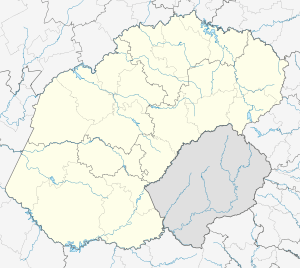Oranjeville
| Oranjeville | |
|---|---|
 Oranjeville  Oranjeville  Oranjeville
| |
| Coordinates: 26°59′S 28°12′E / 26.983°S 28.200°ECoordinates: 26°59′S 28°12′E / 26.983°S 28.200°E | |
| Country | South Africa |
| Province | Free State |
| District | Fezile Dabi |
| Municipality | Metsimaholo |
| Area[1] | |
| • Total | 8.57 km2 (3.31 sq mi) |
| Population (2011)[1] | |
| • Total | 5,166 |
| • Density | 600/km2 (1,600/sq mi) |
| Racial makeup (2011)[1] | |
| • Black African | 93.1% |
| • Coloured | 0.3% |
| • Indian/Asian | 0.3% |
| • White | 6.1% |
| • Other | 0.3% |
| First languages (2011)[1] | |
| • Sotho | 72.4% |
| • Zulu | 8.0% |
| • Xhosa | 7.7% |
| • Afrikaans | 7.1% |
| • Other | 4.8% |
| Postal code (street) | 1995 |
| PO box | 1995 |
| Area code | 016 |
Oranjeville is a small town situated on the banks of the Wilge River in the Free State province of South Africa.
The town is on the southern bank of the Vaal Dam, 14 kilometres (9 mi) south-east of Deneysville and 46 kilometres (29 mi) north-east of Heilbron. It takes its name from the Orange Free State, Oranje-Vrystaat in Afrikaans.[2]
It was established as a stop-over for wagoners travelling between Heilbron, Frankfort and Vereeniging. It was named after the Prince of Orange of the Netherlands. The main road passing though the town is the R716 road, called Malan Street in Oranjeville.
References
- 1 2 3 4 "Main Place Oranjeville". Census 2011.
- ↑ "Dictionary of Southern African Place Names (Public Domain)". Human Science Research Council. p. 353.
This article is issued from Wikipedia - version of the 8/18/2016. The text is available under the Creative Commons Attribution/Share Alike but additional terms may apply for the media files.
.svg.png)